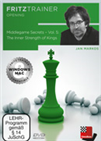A clear victory for Kollars
Dmitrij Kollars was in the lead by a full point before the final round at the German Individual Championships in Ostfildern on Tuesday, and therefore had the best prospects of winning the title. After the national number 2 in the German rankings - behind Vincent Keymer - had defeated the 2023 champion Vitaly Kunin in round 8 (see analysis of the game below), Kollars faced Leonardo Costa, who had sensationally won the Championship in 2022 at the age of 14, in the ninth and final round.
Kollars achieved a better position out of a Spanish Opening. Costa could hardly refuse his offer of a draw, and so Kollars secured the title of 2024 German champion.
 In this video course, kings will play a role of strong and active pieces. We will explore how Kings can be helpful in defence and prophylaxis, or even in attack!
In this video course, kings will play a role of strong and active pieces. We will explore how Kings can be helpful in defence and prophylaxis, or even in attack!
The new German champion
This year, the open championship was held as a round-robin tournament for the first time in a long time. Kollars was the outright winner with 6/9 points after scoring 6 draws and victories over Rainer Buhmann, Roven Vogel and Vitaliy Kunin.
Niclas Huschenbeth, Dennis Wagner and Roven Vogel tied for second with 5½ points each.
In the final round, the participants in the Championship once again provided the spectators on site and on the Internet with a series of colourful and exciting games. It turned out that Rasmus Svane must be under the special protection of the chess goddess Caissa because after he had managed to draw an endgame a piece down in the previous round, Caissa once again favoured him in his game against Marius Deuer - it was a second consecutive draw from an inferior position for Svane.

Thank you, Caissa!
Niclas Huschenbeth played a model game out of an Advance Variation in the French Defence against the veteran Daniel Fridman. Both grandmasters were on top of their game with their knowledge of the variation. In the course of the middlegame, however, Huschenbeth had the better ideas and decided the game with the help of a pawn push in the centre.
 In the Schara-Hennig Gambit black sacrifices a pawn and in return he gets a lead in development. From that point on black has two options. Playing against white’s king or trying to prevent white from developing.
In the Schara-Hennig Gambit black sacrifices a pawn and in return he gets a lead in development. From that point on black has two options. Playing against white’s king or trying to prevent white from developing.
From left to right: Niclas Huschenbeth (2nd place on tiebreaks), Dmitrij Kollars (1st place) and Dennis Wagner (3rd place on tiebreaks)

All the participants
Final standings
All games
Fiona Sieber wins the Women's Championship
In the Women's Masters, also a round-robin tournament, which is not a national championship unlike the open event, Fiona Sieber had secured tournament victory with a round to spare - she had only a 1-point advantage over Kateryna Dolzhykova and Lara Schulze, but had defeated both players in their direct encounters (the first tiebreak criterion).
Sieber still had to play the tricky Luisa Bashylina in the final round still. Bashilyna achieved a promising position against Sieber's Nimzo-Indian Defence after sacrificing a pawn, but lost her advantage after a skirmish in the middlegame. After being forced to exchange queens, Sieber was able to use her material advantage in the endgame to end the event with a win.

Fiona Sieber
 The Jobava London System is a minor form of the London System. White tries to play Lf4 quickly followed by Nc3.
The Jobava London System is a minor form of the London System. White tries to play Lf4 quickly followed by Nc3.After completing her studies, Sieber wants to spend a year playing tournament chess. Her year as a 'chess pro' has started well!
Kateryna Dolzhykova finished second, ahead of Lara Schulze.

From left to right: Kateryna Dolzhykova (2nd), Fiona Sieber (1st) and Lara Schulze (3rd)

All the participants of the Women's Masters
Final standings
All games
Links






























